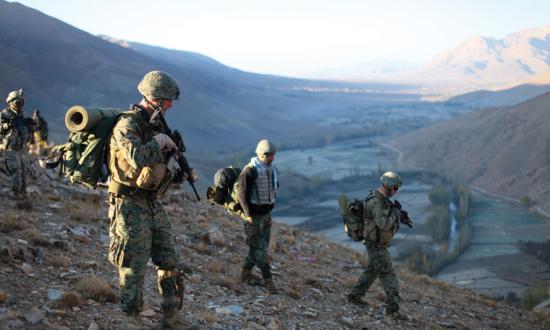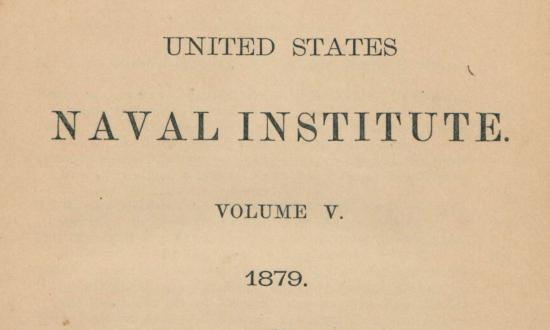A liberal arts school; Officer Candidate School. These two places connote starkly different environments. One is associated with poetry readings and well-landscaped quads; the other evokes imagery of screaming drill instructors and lots of burpees. I had these experiences back-to-back, and while it was a startling juxtaposition, I now appreciate the synergy between these two programs as well as the important role the liberal arts play in the military profession.
On the surface, the environments of Officer Candidate School (OCS) and my alma mater, the University of Texas at Austin, could hardly be more different. OCS is a highly structured program in which every minute of a candidate’s day is pre-planned, and stress is a feature rather than a flaw of the training environment. Modern universities, however, are much more freewheeling. Actual attendance policies depend on the course instructor, and nearly everyone who attended college knows a classmate who made it semesters without seeing the inside of a classroom except for exam days. Indeed, some of the most formative activities for college students involve how they use unstructured idle time instead of formal training. And perhaps infamously, today’s universities take an opposite view of stress on students, seeking to eliminate stress when possible and provide ample resources to shelter students from too much of it.
In the bigger picture, OCS and a liberal arts college are not so different, especially in their fundamental purposes. The OCS mission statement is, “To morally, mentally, and physically develop future Leaders of Character and Competence—imbuing them with the highest ideals of Honor, Courage, and Commitment in order to serve as Professional Naval Officers worthy of special trust and confidence.” This statement’s commitment to the holistic development of leaders is reminiscent of the interdisciplinary programs I gravitated toward in my undergraduate years. The University of Texas’ mission statement is longer but complemented by a succinct “core purpose” statement: “To transform lives for the benefit of society.” The university’s motto, “What starts here changes the world,” also implies that developing leaders is a core mission of one of the largest universities in the country. Many universities, both public and private, strive not only to educate citizens but produce leaders in the process.
The overlap between these very different approaches reveals both a truth and an opportunity. A liberal arts education—the goal of which is best defined by former President of Yale University Bart Giamatti as “to train the whole person to be at once intellectually discerning and humanly flexible, tough-minded and open-hearted; to be responsive to the new and responsible for values that make us civilized”—is integral to the professional development of leaders, but it can also be a valuable tool for leaders to get the most out of the teams and individuals they lead.
To Train or Educate?
While often used synonymously, there is a subtle but important distinction between training and education in the military context. Training aims to provide personnel with baseline knowledge and skills with little variation in outcomes. When a division conducts a training on something like records management, the goal is not to encourage creative new ideas on how to store records, but rather to ensure that everyone in the division is aware of the policies and procedures related to the subject. A significant portion of OCS is dedicated to instilling this baseline in junior officers and leaving the true leadership development to a junior officer’s first divisional chief.
Educating is more aspirational and more difficult to define and achieve. Education develops capabilities and mind-sets. To be precise, the military does not shun education. Educational opportunities for servicemembers are readily available and well-regarded. However, when education instills attributes such as critical thinking and a questioning mind-set, it can threaten to undermine the “good order and discipline” that baseline training is intended to create.
It is tempting to split the difference and conclude that warfighters must be both well-trained and well-educated. It is far harder to define the proper balance between training and education and reconcile the tension between these occasionally opposing tasks. However, because training is easy to conduct and “check-off,” there will always be a tendency for division officers and divisional chiefs to stick to training their division and let sailors pursue education on their own time. Therefore, divisional and departmental leaders should fight against this tendency—most of all because the high-end fight will require more than mere discipline.
Higher Education and the High-End Fight
There are several widely identified causes for concern in great power competition at sea. The first is the numbers game, wherein China’s shipbuilding output vastly outpaces U.S. shipbuilding, and an ever-widening gap has formed between the size of the Chinese and U.S. fleets. Another concern is technological; China has developed technologies such as hypersonic antiship cruise missiles and demonstrated a commitment to competing for the edge in space and cyber capabilities. Less discussed is how the intellectual capital of the two navies compare.
An intangible but significant factor in any naval conflict is not only the strength of the fleets involved and the quality of their technologies, but how a fleet uses its available assets. In the event of conflict with China—during which communications would likely be jammed—officers must think quickly and strategically in the absence of orders.
The conventional wisdom holds that the high-end fight requires investment in technical knowledge and skills. Robust science, technology, engineering, and mathematics (STEM) education in the fleet is certainly a necessary condition, but it is not sufficient—especially because the environments in which new technologies will be used, and even the new technologies themselves, are hard to predict at best. In a robust essay on honing the military’s intellectual edge, former president of the U.S. Marine Corps University Major General William Mullen and his coauthors argue that training to apply standard fixes to known problems is obsolete in an era of unpredictability. Mullen and his coauthors quote Nobel Prize-winning economist Herbert Simon to caution against relying on technological advancement at the expense of critical thinking: “What we must avoid above all is designing technologically sophisticated hammers and then wandering around to find nails that we can hit with them.” Creativity in warfighting can be a wildcard that gives one fleet the edge over its adversary; it requires well-educated, not just well-trained, sailors.
The U.S. military likely has an asymmetric advantage over the People’s Liberation Army (PLA) when it comes to the intellectual environments of the respective forces. The PLA relies on conscription to fill its enlisted ranks while its officers must navigate heavy oversight from Chinese Communist Party political commissars. Neither of these factors are conducive to flexible thinking. Moreover, the strict indoctrination of the PLA makes it inherently susceptible to groupthink and blind adherence to doctrine. This shortcoming, coupled with the fact that China has not fought a war since its skirmish with Vietnam in 1978, raises serious questions about how well the PLA can fight amidst the fog of war.
Educating is Leading
At every level of leadership, one of a leader’s core duties is ensuring that their unit is sufficiently trained. In practice, this often involves an Excel spreadsheet ensuring that every member of a unit has their general military trainings (GMTs) up to date. This presents an opportunity for leaders to go beyond banal PowerPoint trainings and contribute to the education of their sailors by adopting a liberal arts model.
The liberal arts model of education is compatible with developing naval professionals because it helps form innate faculties that are applicable in multiple environments. “Liberal arts” as a style of education can mean many things. It is often erroneously associated with the supposed left-wing political bend of American college campuses. More accurately, a liberal arts education is inherently broad, spanning many academic disciplines and especially attentive to the interconnections between subjects. A typical liberal arts program at a major university will require students to take classes in many different subjects, including both humanities and natural sciences. Finally, a common characteristic of liberal arts curricula is a prioritization of independent thought, cultivated through rigorous writing assignments and plenty of reading.
The foremost benefit of a liberal arts education is learning how to learn. The breadth of liberal arts programs forces students to adapt to digesting information in different modes. Someone well educated in the liberal arts will be capable of digesting verbose prose, deciphering scientific equations, and analyzing causes and consequences of historical events. A student of multiple fields can adapt their way of understanding to the format of the information presented to them. This intellectual agility enables a military professional to quickly adapt to new theaters of operation or new technologies.
Students of the liberal arts are also able to refine their ability to concisely communicate complex ideas. A common characteristic of liberal arts courses, regardless of the subject area, is open-ended inquiries. This is radically different from most GMTs, which evaluate the ability to retain information through multiple-choice quizzes. The ability to write and speak clearly, concisely, and coherently is a fundamental skill for both officers and enlisted. Officers must convey their intent to their units in a direct manner, and in response, enlisted members must be able to articulate their needs and obstacles back to their leadership. Most liberal arts students will be familiar with John Trimble’s Writing with Style, where he defines writing as the “art of creating desired effects.”1 Learning to write well in academic settings can have obvious benefits to the effectiveness of leaders and their teams.
A third asset gained through a liberal arts approach is a broad base of knowledge and an awareness of the intersections between disparate fields. Today’s military places a premium on narrow, technical knowledge. Yet wars cannot be won through any single weapon, but only through a concert of capabilities in support of each other. Understanding how ideas from one field can be applied to another can enable sailors to better understand how departments on a ship work together or how different platforms in a task force support each other. Moreover, a liberal education does not just impart facts and knowledge about what and where, but also frameworks and context for understanding for why and how.
This last benefit also makes the liberal arts a valuable leadership tool. Sailors in one’s division or department will have more buy-in when they can understand the bigger picture of their mission. Taking the time to educate rather than simply train the members of a division or department can also show them that their leadership cares enough to commit time and effort into their subordinates’ intellectual development.
Implementing the Liberal Arts Approach
My most direct exposure to a liberal arts approach in action was when I participated in a series of discussions called “Coffee Hours” hosted by the University of Texas’ Clements Center for National Security. On alternating weeks, a student would moderate a discussion on a strategic issue open to all students on campus, regardless of their field of study. Because these discussions were open to students of all backgrounds, they always granted a multidisciplinary view on a given national security issue. Philosophy or engineering students with little background in international relations coursework often had immensely valuable insights on everything from competition with China to the ethics of drone warfare. They also helped students formulate their thoughts, articulate them, and answer rebuttal questions on the fly. These discussions generated many questions but few definite answers, leading participants to appreciate the nuances of these “bigger picture” issues.
I hope to implement a version of this with my first division, perhaps rebranding them “Strat-Chats” and inviting all members of my division to sit down once a month to talk about a strategic issue facing the Navy or the military profession. Going beyond “death by PowerPoint” will hopefully make my sailors better thinkers and better prepared to take on the challenges that lie ahead.
1. John Trimble, Writing with Style (Upper Saddle River, NJ: Prentice-Hall, 2000), 6.






